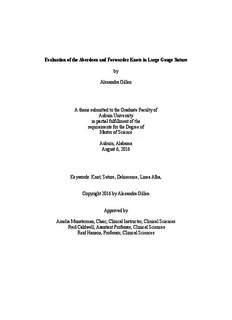
Evaluation of the Aberdeen and Forwarder Knots in Large Gauge Suture by Alexandra Gillen A ... PDF
Preview Evaluation of the Aberdeen and Forwarder Knots in Large Gauge Suture by Alexandra Gillen A ...
Evaluation of the Aberdeen and Forwarder Knots in Large Gauge Suture by Alexandra Gillen A thesis submitted to the Graduate Faculty of Auburn University in partial fulfillment of the requirements for the Degree of Master of Science Auburn, Alabama August 6, 2016 Keywords: Knot, Suture, Dehiscence, Linea Alba, Copyright 2016 by Alexandra Gillen Approved by Amelia Munsterman, Chair, Clinical Instructor, Clinical Sciences Fred Caldwell, Assistant Professor, Clinical Sciences Reid Hanson, Professor, Clinical Sciences Abstract Methods: Forwarder, Aberdeen, surgeon’s and square knots were tested using large gauge suture under linear tension on a universal testing machine, recording knot holding capacity (KHC). Relative knot security (RKS) was calculated as a percentage of KHC. Knot volume and weight were assessed by a digital micrometer and balance, respectively. An ANOVA and post hoc testing compared strength between number of throws, suture, suture size, and knot type. P<0.05 was considered significant. Results: Forwarder and Aberdeen knots had a higher KHC and RKS than surgeon’s or square knots for all suture types and number of throws (P<0.001). For all suture materials, no Forwarder or Aberdeen knots unraveled. Forwarder and Aberdeen knots had a smaller volume and weight than surgeon’s and square knots with equal number of throws (p<0.001). Conclusions: The Forwarder and Aberdeen knots were shown in vitro to be stronger, more secure, and smaller than surgeon’s and square knots. ii Acknowledgments There are many people who have made this investigation possible and enjoyable. Particular thanks must go to Dr Amelia Munsterman, Dr Reid Hanson and Dr Fred Caldwell who have been an incredible committee and wonderful mentors. I would also like to thank Dr Ramsis Farag for both his expertise in designing the study and his technical assistance. My resident mates, Val, Mattie, Matt, Leah, Rosemary, Marta, Mariano, Fernanda, Gustavo, Rochelle, Katie, Jenna and Jessie – thank you for a great 3 years. iii Table of Contents Abstract ......................................................................................................................................... ii Acknowledgments ........................................................................................................................ iii List of Tables ................................................................................................................................ v List of Figures .............................................................................................................................. vi List of Abbreviations .................................................................................................................. vii I. Introduction and Literature Review ......................................................................................... 1 a. Ventral Midline Celiotomy Incisions .......................................................................... 1 i. Comparisons of Methods of Access for Abdominal Surgery ..................................... 1 ii. Complications Following Ventral Midline celiotomy in the Horse ........................... 3 iii. Consequences of Incisional Complications ............................................................... 4 iv. Risk Factors for Incisional Complications .................................................................. 5 b. Wound Healing ............................................................................................................. 8 i. Phases of Wound Healing ............................................................................................. 8 c. Principles of Suture Material, Suture Patterns and Knots ........................................... 10 i. Suture Materials .......................................................................................................... 10 ii. Suture Size ................................................................................................................. 19 iii. Suture Pattern .......................................................................................................... 20 iv. Knot Type ................................................................................................................ 22 v. Size of Knot .............................................................................................................. 26 d. Techniques in Ventral Midline Celiotomy ................................................................. 28 iv i. Techniques for Closing a Ventral Midline Celiotomy Incision in Humans .............. 28 1. Suture Material ........................................................................................................ 28 2. Suture Gauge ........................................................................................................... 32 3. Suture Pattern .......................................................................................................... 32 4. Incision .................................................................................................................... 36 ii. Techniques for Closing a Ventral Midline Cleiotomy Incision in Small Animals ... 38 1. Suture Material ........................................................................................................ 38 2. Suture Gauge ........................................................................................................... 39 3. Suture Pattern .......................................................................................................... 41 4. Knot Type and Knot Size ........................................................................................ 42 iii. Considerations for Closing a Ventral Midline Celiotomy Incision in the Horse .... 43 1. History of Closure of the Equine Linea Alba ........................................................ 43 2. Incision ................................................................................................................... 43 3. Suture Material ....................................................................................................... 45 4. Suture Gauge .......................................................................................................... 48 5. Suture Pattern ......................................................................................................... 49 6. Knot Type .............................................................................................................. 52 7. Knot Size ................................................................................................................ 54 iv. Current Techniques for Closure of a Ventral Midline Celiotomy in the Horse ...... 54 d. Methods of Evaluating Knots and Suture Material .................................................... 55 i. Nomenclature ............................................................................................................. 55 ii. Methods of in vitro testing ........................................................................................ 55 v iii. Methods of ex vivo testing ....................................................................................... 57 iv. Methods of testing in vivo ........................................................................................ 58 e. Objectives ................................................................................................................... 59 II. Materials and Methods ......................................................................................................... 60 III. Results ................................................................................................................................. 65 IV. Discussion ............................................................................................................................ 69 V. Conclusion ............................................................................................................................ 74 References ................................................................................................................................. 75 Appendix: Pictures and Tables ................................................................................................ 81 vi List of Tables Table 1 ....................................................................................................................................... 83 Table 2 ....................................................................................................................................... 89 v List of Illustrations Illustration 1 ............................................................................................................................... 81 Illustration 2 ............................................................................................................................... 82 Illustration 3 ............................................................................................................................... 84 Illustration 4 ............................................................................................................................... 85 Illustration 5 ............................................................................................................................... 86 Illustration 6 ............................................................................................................................... 87 Illustration 7 ............................................................................................................................... 88 Illustration 8 ............................................................................................................................... 90 vi List of Abbreviations KHC Knot Holding Capacity RKS Relative Knot Security TS Tensile Strength AVNOA Analysis of variance vii I. Introduction and Literature Review a. Ventral Midline Celiotomy Incisions i. Comparisons of Methods of Access for Abdominal Surgery Surgical access to the abdomen is required for a variety of reasons in both humans and domestic species. In humans, the most common reasons for abdominal surgeries include appendectomy, cesarean section, hysterectomy and exploratory surgery (Rath et al. 1996). In horses, the most common reason for performing abdominal surgery is abdominal pain (colic), with 1.4-10% of colic cases requiring surgical management (Traub-Dargatz et al. 2001; Tinker et al. 1997; Mair et al. 2007). Other common procedures requiring access to the abdominal cavity are cesarean section, ovariectomy and cryptorchidectomy (Slone 1988; Collier 1980). There are multiple routes by which access to the abdomen can be obtained. In human surgery, the most common method of obtaining access to the abdomen is via a ventral midline celiotomy (Rath et al. 1996). However, this is largely being replaced by laparoscopy for many procedures, such as appendectomy (Hall Long et al. 2001), hysterectomy (Reich et al. 1989) and colorectal resection (Maggiori et al. 2012). Laparoscopy is used in many equine abdominal procedures, especially ovariectomy and cryptorchidectomy (Hendrickson 2006). However, given the weight (150lbs) and volume of the large colon (75-90 liters of ingesta), and the length of the small intestine (on average, 30 meters), 1
Description: